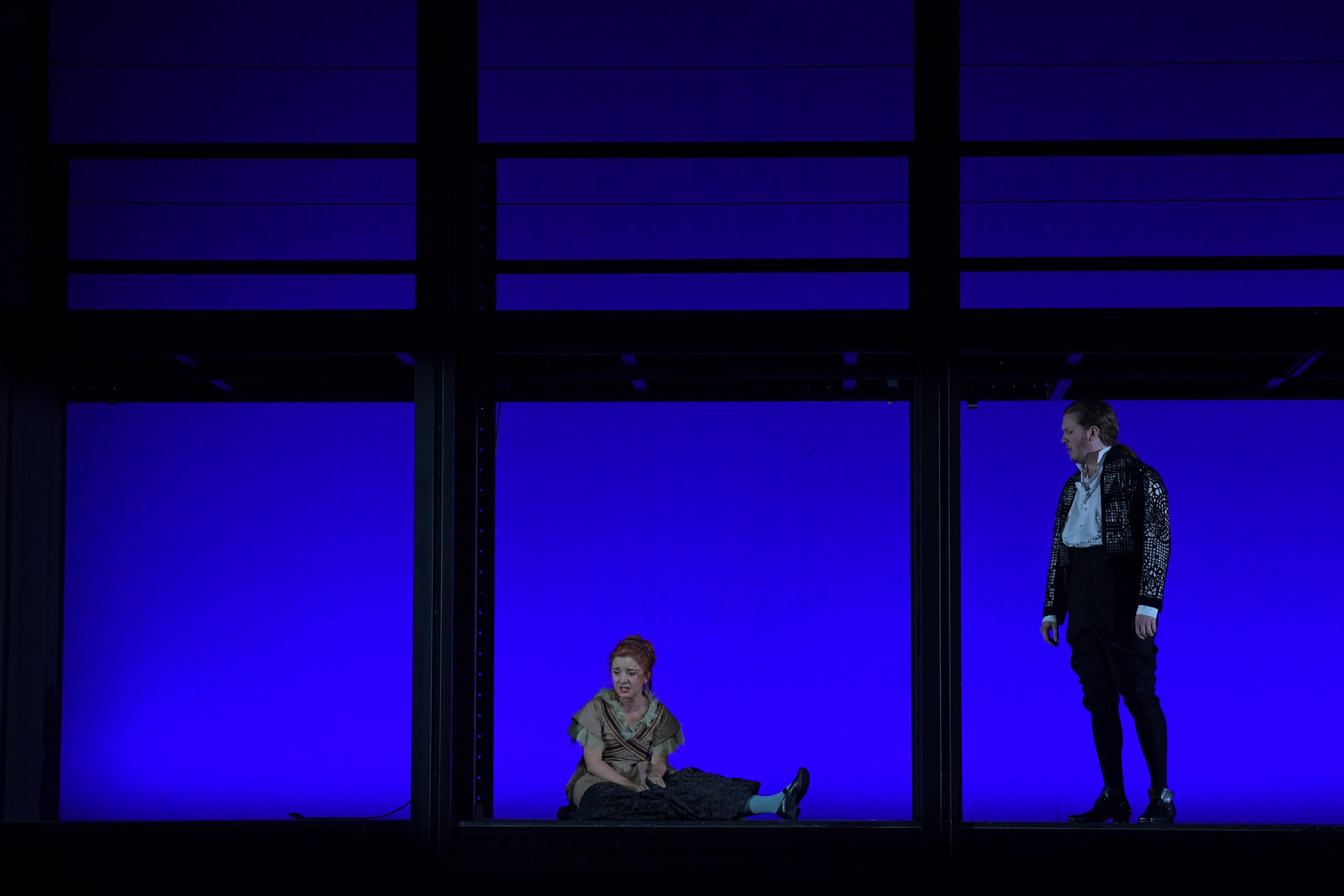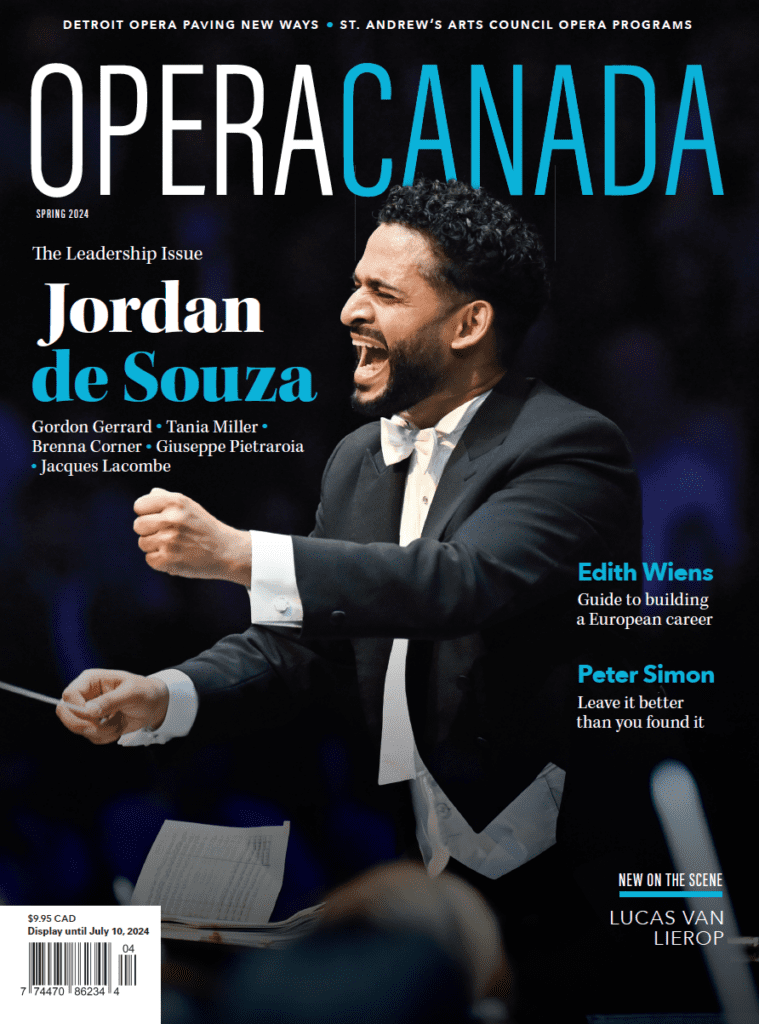Saddled with reviving an Oper Frankfurt production not compliant with pandemic restrictions, Director Caterina Panti Liberovici and her team faced a nearly impossible task: in two weeks, re-stage and rehearse Le nozze di Figaro such that the characters never sing together in the same room. Rather than repurpose old material, Liberovici created an entirely new show—only the costumes remained (seen Sept. 24th).
Thank goodness she did. The 2007 production meant to be in revival had grown irretrievably stale, and could not speak to current, peculiar circumstances. Besides, isolation is an underexplored theme of Mozart’s opera. Each character is plagued by it. The Count, through serial infidelity, has shredded his relationship with his wife who has become so depressed she can hardly leave her room. Figaro and Susanna are driven apart by Figaro’s jealousy. Cherubino fights the lonely shame of adolescent boyhood. But what happens when they enter a world of quarantine and social distancing where physical contact hardly exists?
Spatial constraints could engender insight into collective isolation. Perhaps in the context of a masterwork, the looping conversations of these virus-laden months could take an unexpected turn. Alas, the show mostly sputters along with the usual motions intact. Cherubino still hides under a sheet and jumps out a window (though there’s no window and he runs out from the ground floor.) The slapstick in the sextet and the grand finale remains, though it’s mimed from a distance which is exactly as strange as it sounds. Surely with proper rehearsal time, the staging would have developed beyond these clichés.

Top: Gordon Bintner (Figaro); bottom (l-r): Bianca Tognocchi (Susanna) & Adriana Gonzalez (Countess) in Oper Frankfurt’s Le nozze di Figaro. Photo: Barbara Aumüller
The set is cleverly designed. Its shape resembles two rows of stacked shipping crates, with the small sides open, facing the audience. The containers are stylish with translucent walls supported by flat, slim, metal beams. Their design allows for myriad curtain and lighting combinations including some gorgeous silhouettes (lighting by Olaf Winter). Aside from the Count (a blustery Liviu Holender) and Countess (Adriana González)—whose bedroom is twice the size of the other boxes—no other characters occupy the same container together while singing. The characters do swap compartments with such frequency that I began to doubt the efficacy of the isolation chambers to protect against viral spread. Nonetheless, as a dramatic conceit, the separated rooms reflect our strange times and provide the setting for some moments of raw humanity.
Just as Figaro (Canadian bass-baritone Gordon Bintner) finishes his first act aria “Non più andrai,” the Count, Susanna (Bianca Tognocchi), and Cherubino (Bianca Andrew) exit, leaving Figaro alone in his box. Hardly moving, he looks stunned, like an action figure stiffly posed in its original packaging, its face stuck in an expression not quite human. Figaro is, after all, alone as he schemes. His confidants become props for his machinations as his easy warmth and charm shifts towards mania, isolating him further. Perhaps it’s no wonder jealousy unravels him. Blinded by cleverness, he pushes everyone away.
Unlike Figaro and Susanna, the Count and the Countess are able to sing together (they are in a real-life relationship so an exception could be made.) A poignant moment of character development depends on this exception. The Countess’s second aria “Dove sono,” sung with astonishing dynamic contrast by González, begins with quiet intensity, as though the character is interrogating her subconscious for the source of her distress. The Count enters. With her back turned to him, the Countess remains rigid, rejecting his presence. Perhaps this vulnerable monologue is happening in her mind. Then, she addresses the Count, asking, “Why have my memories of happiness not vanished?” (the emphasis is mine). Gaslit, she is undone by a paradoxically distressing hopefulness. If her narcissist husband continues cultivating her shred of nostalgia, she will not leave and her isolation will persist.

Top (l-r): Anthony Robin Schneider (Bartolo), Cecelia Hall (Marcellina), Bianca Andrew (Cherubino), Ekin Su Paker (Barbarina) & Franz Mayer (Antonio); bottom (l-r): Michael McCown (Basilio), Gordon Bintner (Figaro), Bianca Tognocchi (Susanna), Adriana Gonzalez (Countess) & Liviu Holender (Count) in Oper Frankfurt’s Le nozze di Figaro. Photo: Barbara Aumüller
As for the rest of the characters, more quarantined than socially distanced, their chemistry is disrupted by the pandemic’s restrictions. The Countess can’t seduce Cherubino with sotto voce alone. Without their faces nearly touching, the hairs on your arm stand down. Likewise with Susanna’s “Deh vieni” near the opera’s end, despite soprano Bianca Tognocchi’s undulating phrasing that is sexier than the staid, overly-classical interpretation many sopranos strive for, the room stays cold. Seduction wilts when intimacy is forbidden.
But all this nitpicking does little justice to the reality that, even in a quarter-full theatre where coughs provoke fear, it’s a pleasure to witness professional opera singers working again. As applause for the socially distanced bows calmed, the curtain fell and masks rose. The small crowd shuffled out to a world incongruous with the characters’ final plea: dance, be merry, and celebrate—together!






